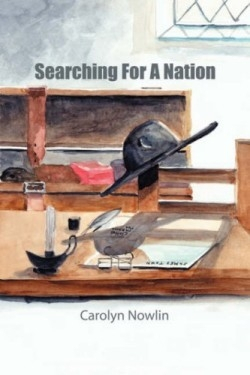Searching for a Nation
Carolyn Nowlin’s first full-length novel features her own Hammond family ancestors. She begins with Martin Hammond who leaves home—a place without a name—for the New World in January 1635. Sparse details and reproductions of historical documents enhance the story of Martin and his progeny through their hardscrabble adaptation to the wilderness and their efforts to build a life in America.
The Hammond family readily represents the American experience from the early years of settling the new continent to those just prior to the Civil War. The author recounts a consistent look at daily life offering very few specifics or helpful details to place these rather saintly family members within the historic context of their times. The reader must fill in the blanks concerning the history major events and social context of those eras.
The concept of fiction based upon fact with documents included has merit and finding a nation of people who are related sounds intriguing. Sadly the book doesn’t deliver. Filling only 200 pages documents and all it attempts to cover the lives of family members from 1600 to 1900 but falls woefully short of epic historical fiction expectations.
The author begins her preface by writing “I never had any intentions of writing a book. When in school composition was my worst subject. I did not like writing…” The book is written in a stilted elementary composition style. This vague telling rather than showing writing style lacks the crafting of an experienced writer: “Matthias felt weary of traveling. As a dutiful son he willingly did what his parents asked but he wondered when they would finally settle down and stop moving. He kept his feelings to himself wondering if the other family members felt the same. He did not dare ask anyone what they thought about the constant traveling.”
The book’s strongest parts appear in Chapter Nine “Our Memories.” Here the story is told in first-person narrative style. The characters come to life with such description as “I remember how little Grandma Hammond was and she always wore cotton dresses and a kitchen apron. She wore her hair in a twisted bun on the back of her head and sometimes she would let me brush it for her.”
Although the book appears too lightweight for serious consideration as epic historical fiction or adult fiction it works as juvenile historical fiction. The book would benefit from the use of fiction techniques such as fleshed out scenes background exposition showing rather than telling as well as character setting and plot development. If written for juveniles an appendix of genealogical resources or a short article about how to research a family history could enhance the marketability of the book.
Disclosure: This article is not an endorsement, but a review. The publisher of this book provided free copies of the book and paid a small fee to have their book reviewed by a professional reviewer. Foreword Reviews and Clarion Reviews make no guarantee that the publisher will receive a positive review. Foreword Magazine, Inc. is disclosing this in accordance with the Federal Trade Commission’s 16 CFR, Part 255.

